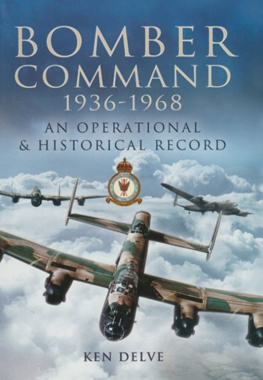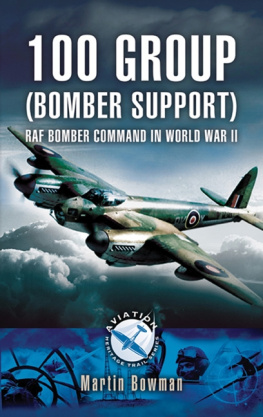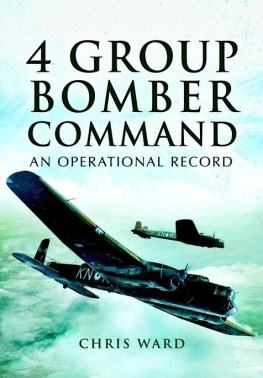RAF Bomber Command
19361968
RAF Bomber Command
19361968
AN OPERATIONAL AND HISTORICAL RECORD
KEN DELVE

First published in Great Britain in 2005 by
PEN & SWORD AVIATION
an imprint of
Pen & Sword Books Ltd
47 Church Street
Barnsley
South Yorkshire
S70 2AS
Copyright Ken Delve, 2005
ISBN 1 84415 183 2
The right of Ken Delve to be identified as Author of this Work
has been asserted by him in accordance with the
Copyright, Designs and Patents Act 1988.
A CIP catalogue record for this book is
available from the British Library.
All rights reserved. No part of this book may be reproduced or transmitted
in any form or by any means, electronic or mechanical including photocopying,
recording or by any information storage and retrieval system, without permission
from the Publisher in writing.
Typeset by Concept, Huddersfield, West Yorkshire
Printed and bound in Great Britain by
CPI UK
Pen & Sword Books Ltd incorporates the Imprints of
Pen & Sword Aviation, Pen & Sword Maritime, Pen & Sword Military,
Wharncliffe Local History, Pen & Sword Select,
Pen & Sword Military Classics and Leo Cooper.
For a complete list of Pen & Sword titles please contact
PEN & SWORD BOOKS LIMITED
47 Church Street, Barnsley, South Yorkshire, S70 2AS, England.
E-mail: enquiries@pen-and-sword.co.uk
Website: www.pen-and-sword.co.uk
Contents
Introduction and
Overview
D uring the Second World War Bomber Command flew around 390,000 sorties for the loss of 8,953 aircraft on operational missions; that number does not include another almost 1,400 that crashed in the UK whilst airborne on an operational mission. The cost in aircrew lives was over 47,000, to which must be added those killed in accidents or training a further 8,000 plus; it is generally accepted that the total of lives lost is around 55,000. What did the six years of the bombing offensive achieve? Supporters and critics were active at the time and in the 60 years since the end of the war the argument has raged even more fiercely. As with all history the benefits of hindsight and access to previously classified documentary sources has to be balanced by the researchers removal in time and context from the period under study. To understand truly decisions, policies, actions and attitudes is all but impossible. This book covers the entire period of Bomber Command from its origin in 1936 to its demise into Strike Command in 1968. Whilst all periods of the Command are covered it is inevitable that the major focus is on the period of the Second World War. The book has been divided into five main sections: an Introduction and Overview, which sets the framework for the development of Bomber Command and includes both policy and politics; an Operations chapter, which focuses on the combat operations of the Command; a brief look at each of the operational Groups; an overview of aircrew training; and, finally, an Aircraft chapter, looking in chronological sequence at all operational aircraft types and one ballistic missile used by Bomber Command. The annexes provide a variety of historical data.
It seems appropriate to open this overview with a few words from the most famous of Bomber Commands leaders, Sir Arthur Harris: There are no words with which I can do justice to the aircrew under my command. There is no parallel in warfare to such courage and determination in the face of danger over so prolonged a period. These words from Bomber Commands wartime leader, Air Marshal Arthur T. Harris are a fitting tribute to the sacrifice made by the Command in six years of war. Only one force on the Allied side was continuously involved with active operations against the German homeland RAF Bomber Command. The day the war started a Blenheim of 139 Squadron flew a reconnaissance sortie to locate German shipping and for the next six years the Command took the war to the enemy, at first with limited effect but from 1942 with increasing resources and greater accuracy, and with an ever greater impact.
Origins and doctrine
Strategic bombing theory was developed in the latter years of the First World War and was a combination of the German raids on England and the Allied, especially Royal Flying Corps/Royal Air Force, bombing campaign, although this was only just starting to get into its stride when the Armistice was signed in November 1918. Despite the fact that strategic bombing had not really been evaluated in the First World War it became a central tenet of air power theory in the post-war period. In part this was because it was the one independent decisive (potentially) role that the air forces could perform. For the RAF this was enshrined as the Trenchard Doctrine: the nation that would stand being bombed longest would win in the end to win it will be necessary to pursue a relentless offensive by bombing the enemys country, destroying his sources of supply of aircraft and engines, and breaking the morale of his people. This doctrine of a war winning bomber force remained the focus of doctrine with the major air forces throughout the 1920s. In May 1928 Trenchard, whose views still carried great weight, circulated a forceful memo to counter: an unwillingness on the part of the other Services to accept the contention of the Air Staff that in future wars air attacks would most certainly be carried out against the vital centres of commerce and of the manufacture of munitions of war of every sort no matter where these centres were located. He stated that the RAF doctrine was to break down the enemy means of resistance by attacks on objectives selected as most likely to achieve this end it being better to attack munitions at source (the factory) than on the battlefield this would become a well-rehearsed argument by Bomber Command throughout the Second World War. It would, he believed, have greater effect for less effort, and would include dissuading workers from working in the factories. The Hague Convention allows for military targets, including production centres. What is illegitimate, as being contrary to the dictates of humanity, is the indiscriminate bombing of a city for the sole purpose of terrorising the civilian population. Bomber Command would later take great care to stress the military significance of its city targets, whilst the German propaganda machine would refer to the Terrorflieger. The other Chiefs of Staff in their respective memos were not convinced, and also expressed concern over being bombed in return; it must be remembered that this was a period when the independence of the RAF, in part budget-driven, was under threat and the arguments, as such tri-Service debates usually are, was writ large with vested interest.

Bomber Command suffered 55,000 aircrew casualties in the Second World War; a number of squadrons lost 1,000 aircrew during the war.

Bomber Command Badge: In front of a thunderbolt gules winged grey, an Astral Crown Or (elements of this badge were subsequently used in the Strike Command badge). The thunderbolt represents Bomber Commands striking power and the Astral Crown is indicative of the success of its operations. Motto: strike Hard Strike Sure. The badge was approved in March 1947 by King George VI.
The debates were largely hypothetical at the time as the RAFs bomber strength in the early 1930s was pitiful with five night- and six day-bomber squadrons, all with slow biplanes with very limited bomb loads, hardly the material with which to deliver an aerial bombardment of any significance.

















